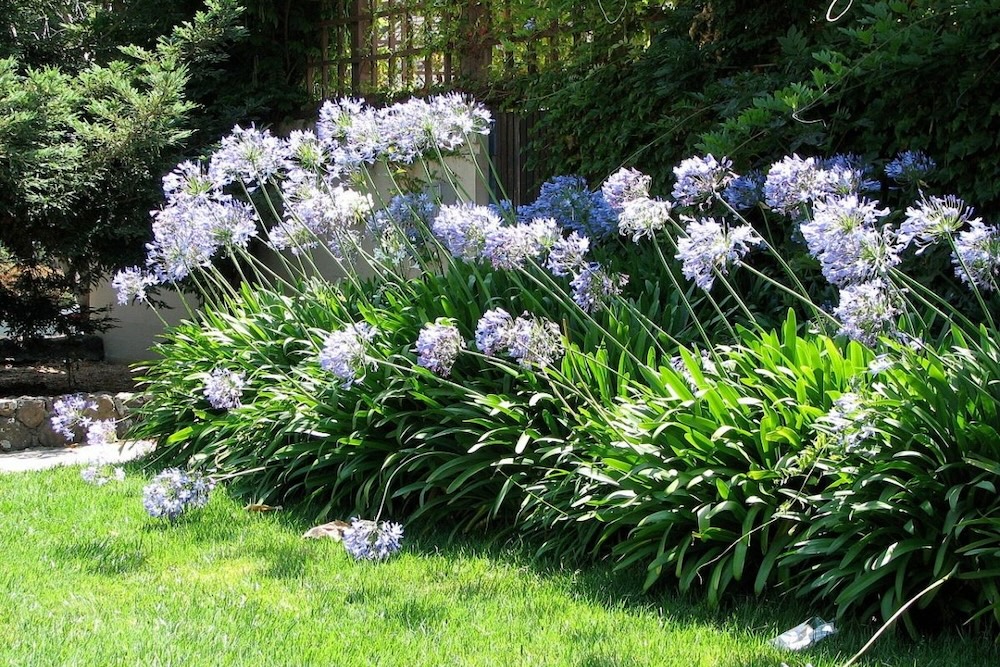Agapanthus Buddy Plants: Perfect Pairings for Your Garden
Agapanthus Buddy Plants: Perfect Pairings for Your Garden
Blog Article
Understanding the Art of Agapanthus Treatment: Essential Actions for Healthy Growth and Vibrant Flowers
In the world of cultivation, the cultivation of agapanthus stands as a fulfilling endeavor for those who seek to support these stylish blooming plants. With their striking blossoms and stylish vegetation, agapanthus has actually caught the interest of garden enthusiasts worldwide. Nonetheless, achieving ideal development and vivid blooms calls for a nuanced approach that encompasses various vital actions. From picking the appropriate selection to mastering trimming methods, the journey towards growing thriving agapanthus plants is multifaceted and holds the key to opening the complete possibility of these herb gems.

Selecting the Right Agapanthus Variety

When picking the ideal Agapanthus variety for your yard, take into consideration variables such as climate viability, flower color, and development routine. Additionally, take into consideration the climate in your region to ensure the Agapanthus range you select can grow in your details problems. Recognizing the development behavior of various Agapanthus varieties is crucial for appropriate placement within your yard.
Suitable Growing Conditions
Taking into consideration the optimum environmental demands is crucial for successful Agapanthus farming. Agapanthus flourishes in well-draining soil with a slightly acidic to neutral pH level. When growing, pick a place that gets full sunshine to partial color. In hotter climates, offering some afternoon shade can avoid scorching of the leaves. Agapanthus plants are sensitive to cold temperature levels and must be protected from frost during winter months.
To make sure healthy development and dynamic flowers, plant Agapanthus light bulbs at a depth of about 2-4 inches and room them 8-12 inches apart. Mulching around the base of the plants assists retain wetness and suppresses weed development.
Watering and Fertilizing Tips
Maintaining appropriate moisture degrees and offering important nutrients are key elements in the treatment regimen for Agapanthus plants. It is important to strike a balance when it comes to sprinkling Agapanthus. If overwatered, these plants favor consistently wet dirt but are vulnerable to root rot. During the expanding period, water deeply when a week, making certain the soil is well-draining to avoid waterlogging. In hotter environments or during durations of drought, more constant watering might be needed to keep the soil equally damp. However, minimize watering in the winter months to protect against water logged problems.
Fertilizing Agapanthus is necessary for advertising healthy and balanced growth and respected blooms. Apply a well balanced plant food, such as a 10-10-10 formula, in the very early spring as new development arises. By adhering to these watering and feeding pointers, you can ensure your Agapanthus plants flourish and create dynamic, long-lasting blooms.
Pruning Methods for Agapanthus
Trimming Agapanthus plants at the appropriate times and with proper methods is vital for keeping their health and wellness and promoting ideal development and flowering. The optimal time to trim Agapanthus remains in late winter or early spring before brand-new growth emerges. Start by removing any yellowing or dead fallen leaves near the base of the plant. Cut them as short as possible without damaging the emerging shoots.
Deadheading spent blossoms can likewise reroute the plant's power into producing more flowers rather than establishing seeds. If you desire to collect seeds for breeding, leave some blossoms to dry their explanation and mature on the plant.
Remember to utilize tidy, sharp devices to make accurate cuts and lower the risk of presenting conditions. Agapanthus. Regular pruning will assist maintain your Agapanthus looking healthy and cool while making sure a bountiful display screen of lovely blooms
Managing Usual Pests and Conditions
After guaranteeing appropriate pruning strategies for Agapanthus, it is important to resolve usual bugs and diseases that can affect the wellness and vigor of these plants. Agapanthus plants are typically hardy but can still succumb certain issues. One common pest that affects Agapanthus is the Agapanthus gall midge. This small, orange fly lays its eggs in the foliage, resulting in distorted development and flower buds that fail to open. To fight this parasite, prune and destroy any type of damaged plant parts and think about utilizing insecticidal soap.
One more common concern is fungal fallen leave place, which offers as dark sores on the fallen leaves. To Check Out Your URL stop fungal diseases, guarantee great air circulation around the plants, avoid overhead watering, and get rid of any kind of contaminated leaves immediately. In addition, Agapanthus plants can experience from origin rot if they are grown in poorly draining pipes dirt. To stop this, plant Agapanthus in well-draining soil and prevent overwatering. By being attentive and taking prompt action against diseases and insects, my explanation you can aid your Agapanthus plants flourish and produce lively flowers.

Final Thought
Finally, understanding the art of agapanthus care involves selecting the best selection, giving suitable growing conditions, proper watering and fertilizing, ideal pruning techniques, and attending to common bugs and conditions. By adhering to these necessary actions, you can guarantee healthy and balanced development and lively blooms for your agapanthus plants. Remember to routinely keep an eye on and preserve your plants to promote their total health and longevity.
To guarantee healthy development and vibrant blooms, plant Agapanthus bulbs at a deepness of about 2-4 inches and room them 8-12 inches apart. By complying with these watering and feeding pointers, you can guarantee your Agapanthus plants thrive and generate lively, long-lasting blooms.
One typical bug that impacts Agapanthus is the Agapanthus gall midge. Furthermore, Agapanthus plants can suffer from root rot if they are grown in inadequately draining pipes dirt. By adhering to these necessary steps, you can guarantee healthy and balanced growth and lively flowers for your agapanthus plants.
Report this page